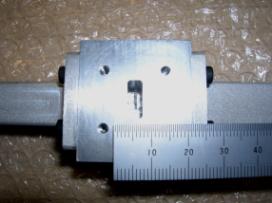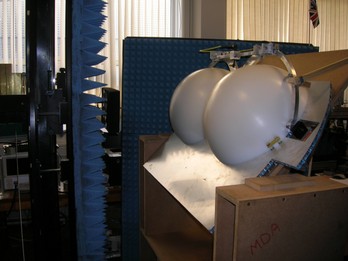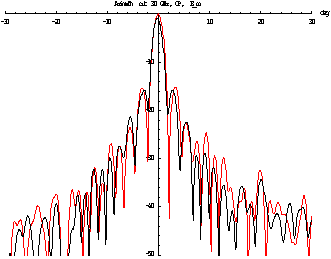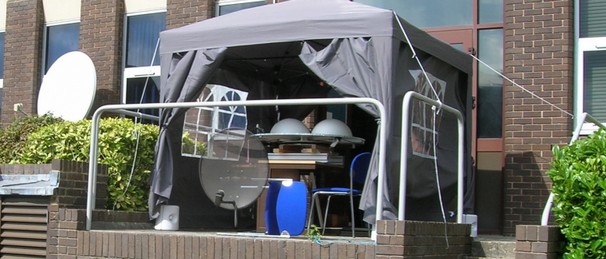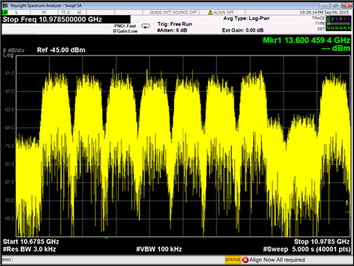Satellite - Antennas Research Ltd

Antennas Research


Antennas Research Ltd. 2024
WebRadio
Antennas for Satellite Communications
1. Multi-beam scanning lens antenna.
I developed this experimental antenna between 2008-2009 while at University of York. More history may be found in the 'archives' section, and several articles on this topic listed under 'publications'. One of these is a magazine article in Microwave Journal.
In 2009 we exhibited the hardware at a satellite conference at Heriot Watt University. Through the south-facing windows seen in the photo we were able to receive satellite TV using the antenna's steerable Ku band feed. A second feed can track on Ka band.
I further developed the lens antenna concept in following years. The array concept allows smaller lenses to be combined. These are more efficient, easier to make, and lower profile than the equivalent single lens. However, unlike the type pictured above, there is only one feed and so only one satellite may be tracked.
2. Low profile lens-array antenna for satellite communications on-the-move.
This highly novel and low profile scanning antenna was developed between 2011 and 2016. Support came from the Advanced Research in Telecommunications Systems (ARTES) programme of the European Space Agency. The work briefly described here is in the public domain and details may be found in the following papers:
- J. Thornton, B. Dalay, D. Smith, “Additive Manufacturing of Waveguide for Ku-band Satellite Communications Antenna”, European Conference on Antennas and Propagation (EuCAP), Davos, Switzerland, 10-15 April 2016
- J. Thornton, “Waveguide Feed Chains for Scanning Lens Array in Ku and Ka Bands”, European Conference on Antennas and Propagation (EuCAP), The Hague, 6-11April 2014. pp. 3645-8.
- J. Thornton, T. Butlin, B. Dalay, “Lens-Reflector Array Antenna for Satellite Communications on the Move”, European Space Agency Workshop on Satcom User Terminal Antennas, 3-5 October 2012, ESTEC, Noordwijk, The Netherland
- J. Thornton and D. Smith, “Feed and Loss Effects in Spherical Lens Antennas for Satellite Communications”, International Journal of RF and Microwave Computer Aided Engineering, Vol 27, issue 1, January 2017
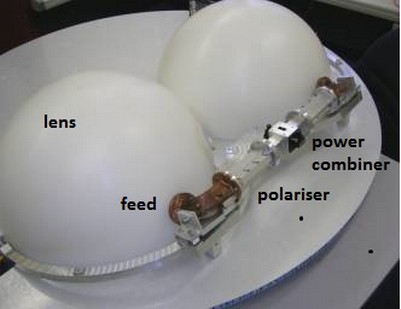
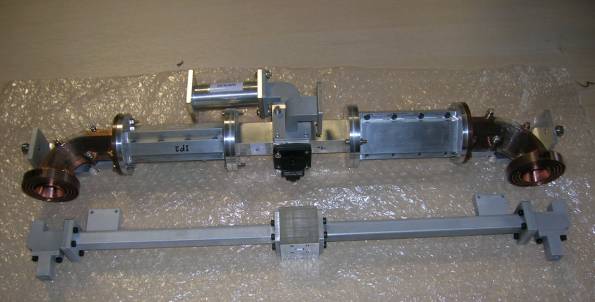
In the above photo, the upper feed chain is for Ku band. The primary feeds, which illuminate each lens, are seen at each end. These carry the guided waves for both transmit and receive frequencies through 90º bends. Next to these are polarisers which may be set to the angle to suit local conditions. Polarisation is dual linear. Later, actuators were added to control polarisation in real time, necessary for on-the-move applications. The lower pictured feed chain is that for Ka band (20 and 30 GHz).
The central component is home to both a 4-port power combiner for receive (including sum and difference ports for monopulse tracking), and a 3-way combiner for transmit. This is illustrated in a little more detail below.
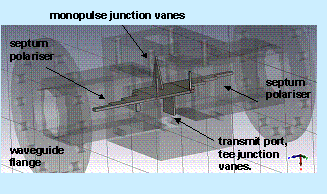
This component was manufactured by spark erosion. Other methods include conventional milling and wire erosion. The internal shape of the waveguide is simulated in fine detail, taking into account the tooling used for manufacture.
More recently, some waveguide components for this project were made by 3D printing of plastic which was then copper plated.
For the Ka band feed chain the polarisation is circular (of opposite sense for transmit and receive bands). This is achieved using a very wide band septum polariser in each primary feed.
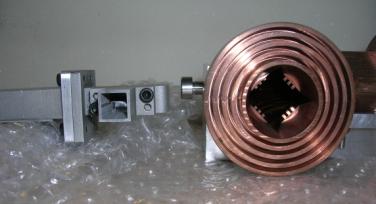 Left: Ka primary feed with internal septum polariser. Ka band hybrid tee with internal matching vanes, for monopulse applications.Right: Ku primary feed with dual mode waveguide bend.
Left: Ka primary feed with internal septum polariser. Ka band hybrid tee with internal matching vanes, for monopulse applications.Right: Ku primary feed with dual mode waveguide bend.
The lens antenna's gain and radiation patterns were measured using the near field range at the University of Northumbria.
Near field scanner and lens antenna Measured patterns (Ka band)
The performance was found to be very good at Ku band, with a gain of about 35 dBi at 12 GHz. To my knowledge, this is superior to any other antenna which can be accommodated inside the same headroom, which here is set by the lens height - just 220 mm. Also, unlike phased array antennas for satcoms-on-the-move, the lens exhibits almost no scan loss over the intended range of elevation angles of 20º to 50º. (At higher angles the waveguide increases the overall antenna height by about another 50 mm.)At Ka band, this prototype functioned quite well but did exhibit significant dielectric loss which reduced the aperture efficiency to less than 50%. Should this development ever be resurrected I would concentrate efforts on finding materials of better purity. These effects, and a fuller presentation of measurement results are found in the journal article noted above (International Journal of RF and Microwave Computer Aided Engineering, January 2017).A pragmatic way of showing the antenna work with a live satellite broadcast - plug it into a satellite TV receiver and compare with a dish.Spectrum analysis.This noisy looking plot is more informative than you might at first think. The 25 MHz wide blocks are broadcasts from satellite co-polarised transponders. Spectrum is re-used on the orthogonal polarisation, using a shifted set of frequency blocks which are centred at the nulls seen above. Poor cross-polar discrimination in the antenna would smear out these nulls and degrade signal quality. The antenna has very good cross-polar discrimination (XPD) because it uses a waveguide feed, and the lens is a symmetrical aperture. Measured XPD varies with polariser setting but is typically better than 25dB. An array type antenna would struggle to achieve this figure, as well as suffering scan loss.
